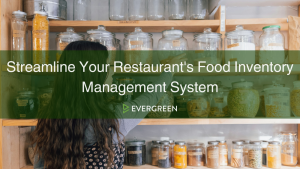Top Four Restaurant Inventory Management Best Practices

In addition to cost control, effective inventory management also plays a vital role in enhancing customer satisfaction. By ensuring that the kitchen is well-stocked with the necessary ingredients and supplies, restaurants can consistently deliver high-quality dishes to their customers, leading to positive dining experiences and customer loyalty. This further underscores the importance of regular inventory audits and implementing a standardized inventory management process to uphold the quality of service and meet customer expectations.
The utilization of technology and software for inventory tracking is pivotal for modern restaurant operations. Let’s look at inventory management essentials in detail so your operation is set up for success from day one.
Benefits of Effective Restaurant Inventory Management
Effective restaurant inventory management is crucial for the success of any food business. One of the key benefits is the ability to maximize profit by reducing food waste, optimizing stock levels, and accurately forecasting supplies. This leads to cost control and improved financial performance, which are essential for the sustainability of a restaurant.
A case study conducted by NetSuite found that as much as 10% of restaurant food is wasted before it even reaches the consumer. This success story demonstrates the tangible impact of effective inventory management on cost reduction and overall financial performance within the restaurant industry.
The Role of Technology and Software in Inventory Management
In the realm of restaurant inventory management, technology and software have become indispensable tools for streamlining operations and maximizing efficiency. Quality management tools and inventory management software are revolutionizing the way restaurants track their inventory, minimize errors, and optimize supply flow.
Advanced inventory management software can provide real-time insights into stock levels, expiration dates, and usage patterns, enabling restaurants to make data-driven decisions to reduce waste and prevent stockouts. By harnessing the power of technology, restaurants can streamline their inventory management processes, leading to significant cost savings and improved customer satisfaction.
The implementation of a backup system and the analysis of data trends are pivotal aspects of leveraging technology and software in inventory management. For example, having a robust backup system in place ensures that restaurants can swiftly recover from any technical glitches or data loss, thereby maintaining seamless inventory operations.
If you and your staff look at data trends such as seasonal demand fluctuations and consumption patterns, your restaurant can make informed decisions about purchasing, pricing, and menu offerings, ultimately optimizing their inventory processes for long-term success.
Ultimately, the integration of technology and software in restaurant inventory management represents a paradigm shift in how restaurants approach the tracking and control of their inventory. By embracing these innovative tools, restaurants can stay ahead of the competition, reduce costs, and deliver an exceptional dining experience to their patrons.
As an example, a report from Restaurant Technology News highlighted that restaurants using automated inventory management software significantly reduce both their total carbon footprint and annual food waste. This demonstrates the tangible efficiency gains and error reduction achieved through the adoption of advanced technology in inventory management.
Types of Restaurant Inventory
Restaurant inventory management involves tracking and controlling different types of inventory, including food, cooking equipment, and supplies. Each type of inventory requires specific attention to ensure efficient management and cost-effectiveness.
Food inventory encompasses perishable and non-perishable items, which must be stored and rotated appropriately to prevent waste and spoilage. Proper storage and inventory organization are essential to maintain the freshness and quality of ingredients, ultimately impacting the taste and presentation of the dishes served to customers. In addition, streamlining the usage of food inventory through accurate portioning and recipe management can help in minimizing waste and controlling costs.
Similarly, managing cooking equipment inventory involves regular maintenance and upkeep to ensure the seamless operation of kitchen equipment. Proper maintenance not only extends the lifespan of the equipment but also prevents unexpected breakdowns, which can disrupt kitchen operations and lead to additional expenses. Moreover, maintaining a well-organized inventory of cooking equipment enables efficient workflow and timely replacements of any malfunctioning items, contributing to a smooth kitchen operation and customer satisfaction.
The inventory of supplies, such as utensils, cleaning materials, and packaging, plays a critical role in supporting the day-to-day operations of a restaurant. Efficient management of these supplies involves establishing par levels, tracking usage, and ensuring timely restocking to avoid interruptions in service and maintain a clean and orderly environment. By optimizing supply inventory, restaurants can uphold operational efficiency, minimize downtime, and deliver a consistent experience to patrons.
Understanding the unique requirements of each type of inventory empowers restaurant owners and managers to implement tailored strategies that contribute to efficient operations, cost control, and customer satisfaction. By leveraging this knowledge, restaurants can enhance their overall inventory management processes and achieve sustainable success in the competitive foodservice industry.
4 Best Practices for Restaurant Inventory Management
When it comes to effective restaurant inventory management, implementing these four best practices is crucial for the success of the business:
- One of the key best practices is the utilization of food inventory software, which can significantly streamline inventory tracking and management processes. By leveraging advanced inventory management software, restaurants can efficiently track stock levels, monitor usage, and automate reordering processes, thereby reducing human errors and saving valuable time.
- Another essential best practice is effectively training staff on the software. Investing in comprehensive staff training ensures that employees are proficient in using the inventory management software to its full potential. This results in accurate data entry, efficient inventory tracking, and better decision-making based on the insights provided by the software.
- Streamlining inventory usage through proper organization is paramount in achieving cost-effectiveness and operational efficiency. By maintaining a well-organized inventory system, restaurants can prevent overstocking, avoid stockouts, and optimize the use of available resources. This practice not only minimizes waste but also contributes to better cost control and profitability.
- Restricting access to inventory data, limiting storage capacity, and maintaining the authenticity and taste of dishes are essential best practices. By controlling access to inventory data, restaurants can prevent unauthorized usage or mishandling of inventory.
By leveraging tools such as our own inventory management features, your restaurant can further streamline inventory usage and prevent overbuying, contributing to efficient and sustainable inventory management processes. Our end-to-end bar and restaurant menu and loyalty program software can provide comprehensive solutions for inventory management, enabling businesses to optimize their inventory practices and drive operational excellence.
Inventory Management Process
An effective restaurant food inventory management process involves meticulous steps aimed at optimizing inventory levels and ensuring cost control. These steps are essential for maintaining the quality and freshness of ingredients, thereby enhancing the overall dining experience for customers.
By calculating your monthly turnover, you can ensure that you have the right amount of inventory on hand, minimizing the risk of overstocking and subsequent spoilage. This approach not only reduces waste and spoilage but also contributes to significant cost savings, aligning with the goal of maximizing profits through efficient inventory management.
The implementation of a standardized inventory management process can lead to improved efficiency and streamlined operations. By adopting a regular inventory audit schedule, restaurants can identify trends in ingredient usage, forecast future supply needs, and minimize the risk of stockouts.
This proactive approach to inventory management helps in maintaining consistent service levels, thus enhancing customer satisfaction and loyalty. The importance of these steps cannot be overstated, as they directly impact the bottom line of the restaurant while also ensuring a positive dining experience for patrons.
In addition, integrating inventory management software into the overall inventory management process can further enhance efficiency and accuracy. By automating inventory tracking, reordering, and data analysis, restaurants can streamline their inventory processes and make informed decisions based on real-time insights. This integration contributes to operational efficiency and cost control, ultimately leading to improved financial performance and customer satisfaction.
Effective restaurant inventory management plays a crucial role in maximizing profitability, reducing food waste, and ensuring customer satisfaction. By implementing best practices and leveraging advanced technology and software, restaurants can streamline their inventory management processes and drive overall operational efficiency.
Our end-to-end inventory management tool offers a comprehensive way to bring your operations to new heights. Ready to unlock new profit in your restaurant or bar today? Request a demo now to see what we can do for you.


